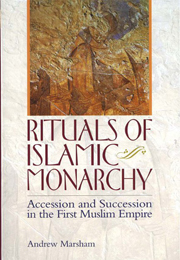Book contents
- Frontmatter
- Contents
- List of maps and figures
- Acknowledgements
- Map 1
- Map 2
- Map 3
- INTRODUCTION
- PART I LATE ANTIQUE ARABIA AND EARLY ISLAM (c. 550–c. 660)
- PART II THE UMAYYAD CALIPHATE (c. 660–750)
- INTRODUCTION
- 4 SUFYANID ACCESSION AND SUCCESSION, c. 660–683
- 5 THE OATH OF ALLEGIANCE IN THE EARLY TRADITION AND POETRY, c. 680–c. 710
- 6 THE MARWANID PATRIMONY AND DYNASTIC SUCCESSION
- 7 MARWANID RITUALS OF ACCESSION AND SUCCESSION
- 8 WRITING AND THE BAYcA IN THE MARWANID PERIOD
- 9 THE QURANIC CONTENT OF THE MARWANID DOCUMENTS
- PART III THE EARLY ABBASID CALIPHATE (c. 750–809)
- PART IV THE MIDDLE ABBASID CALIPHATE (809–865)
- CONCLUSION
- Genealogical table of Quraysh
- Genealogical table of the Abbasid caliphs
- Bibliography
- Index
8 - WRITING AND THE BAYcA IN THE MARWANID PERIOD
from PART II - THE UMAYYAD CALIPHATE (c. 660–750)
Published online by Cambridge University Press: 05 September 2013
- Frontmatter
- Contents
- List of maps and figures
- Acknowledgements
- Map 1
- Map 2
- Map 3
- INTRODUCTION
- PART I LATE ANTIQUE ARABIA AND EARLY ISLAM (c. 550–c. 660)
- PART II THE UMAYYAD CALIPHATE (c. 660–750)
- INTRODUCTION
- 4 SUFYANID ACCESSION AND SUCCESSION, c. 660–683
- 5 THE OATH OF ALLEGIANCE IN THE EARLY TRADITION AND POETRY, c. 680–c. 710
- 6 THE MARWANID PATRIMONY AND DYNASTIC SUCCESSION
- 7 MARWANID RITUALS OF ACCESSION AND SUCCESSION
- 8 WRITING AND THE BAYcA IN THE MARWANID PERIOD
- 9 THE QURANIC CONTENT OF THE MARWANID DOCUMENTS
- PART III THE EARLY ABBASID CALIPHATE (c. 750–809)
- PART IV THE MIDDLE ABBASID CALIPHATE (809–865)
- CONCLUSION
- Genealogical table of Quraysh
- Genealogical table of the Abbasid caliphs
- Bibliography
- Index
Summary
During the late fourteenth or early fifteenth century CE, a senior administrator for the Egyptian Mamluks, Shihāb al-Dīn al-Qalqashandī (d. 1418), composed an authoritative, encyclopaedic manual for secretaries. The Ṣubḥ al-acshā fī ṣinācat al-inshāɔ(‘Daybreak for the Night-Blind regarding the Composition of Chancery Documents’) comprises a vast collection of copies of state documents (the early twentieth-century edition runs to fourteen large volumes), together with discourses on the theory and practice of the scribe and secretary. Long before al-Qalqashandī's time, the dīwān al-inshāɔ (‘chancery’) had taken on a central importance in the administration of most Islamic states, but the scribes of the dīwāns were fully aware that it had not always been so. Men like al-Qalqashandī continued to preserve traditions about the origins and development of every aspect of the scribe's profession, including the production of documents for the pledge of allegiance to the caliph.
The introductory lines on the composition of pledges of allegiance to caliphs in the Ṣubḥ al-a cshā explain that documents were not composed for the bay cas to the Companions of the Prophet who became caliphs in the first decades of Islam. In 694, when al-Ḥajjāj was appointed to govern Iraq, he established the formulaic oaths that became known as ‘the oaths of the bayca’; these oaths then remained in use under the Abbasids. This introduction is followed by a copy of an Abbasid formula for the oath of allegiance.
- Type
- Chapter
- Information
- Rituals of Islamic MonarchyAccession and Succession in the First Muslim Empire, pp. 145 - 167Publisher: Edinburgh University PressPrint publication year: 2009

